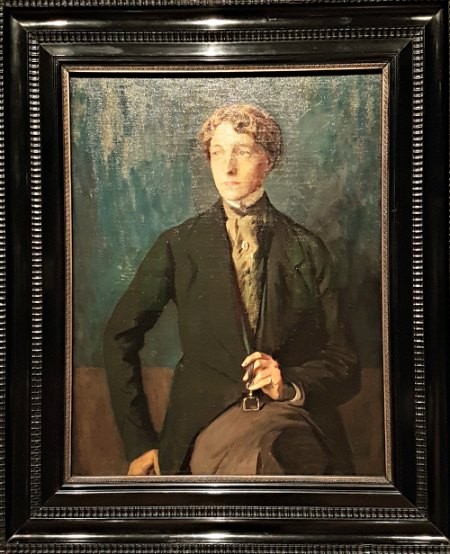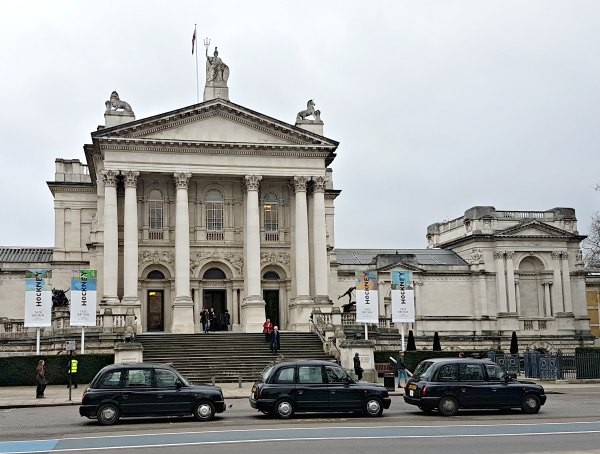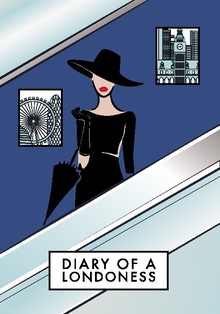Last updated on March 14th, 2018
The word queer sounds well, a bit queer these days, but it’s used in the title of the new exhibition at Tate Britain which opens today. Queer British Art 1861-1967 is a show dedicated to LGBT art, and it’s the first of its kind. It celebrates the 50th anniversary of the 1967 Sexual Offences Act which partially decriminalised male homosexuality in England and Wales. The show is bold, poignant, and as you would expect, very colourful.
Queer British Art takes us on a journey through eight themed rooms examining the role of lesbian, gay, bisexual and transsexual art through painting, photography, queer paraphernalia, magazines and film. Subjects include the pre-Raphaelites and their coded desires, notorious public scandals, theatre as a forum for queer expression, and the 1920s Bloomsbury set and artists who defied conventions.
Queer British Art Highlights
Portrait of a Scandal

Robert Harper Pennington, Oscar Wilde, 1881 (William Andrews Clark Memorial Library)
Making its first public outing is the portrait of Oscar Wilde by American artist, Robert Harper Pennington. It shows a fresh-faced, 27-year-old Wilde on the cusp of fame. The painting was a wedding gift for Wilde and his wife Constance, and it took pride of place in their home on Tite Street, in Chelsea. When Wilde went bankrupt, the painting was purchased by his friend Ada Leverson. Wilde claimed that Leverson’s husband would not allow her to hang it in the drawing room as “it was obviously, on account of its subject, demoralising to young men, and possibly to young women of advanced views.”

Hanging next to Oscar Wilde’s portrait is the door from his prison cell in Reading gaol. During his confinement, he wrote De Profundis, an anguished letter to his lover, Lord Alfred ‘Bosie’ Douglas. The juxtaposition of a debonair Wilde and the object which symbolises both his humiliation and torment is heart-wrenching and utterly brilliant.

Charles Buchel, Radclyffe Hall, 1918 (National Portrait Gallery)
Marguerite Radclyffe Hall was a poet and novelist, best known for writing the first lesbian novel, The Well of Loneliness. In 1928, a judge ordered that all copies be destroyed on the basis that that it was in the public interest to do so. Following the trial, women with cropped hair were viewed with suspicion.
Body Beautiful

Duncan Grant, Bathing, 1911 (Tate)
Duncan Grant was a painter and textile designer, and one of the leading figures in the avant-garde Bloomsbury set. The homoerotic painting depicts seven men swimming in the Serpentine in Hyde Park.

David Hockney, Life Painting for a Diploma, 1962 (Yageo Foundation)
David Hockney produced this tongue-in-cheek painting for his diploma final at the Royal College of Art, in 1962. He copied the male nude from an American body-building magazine and paired it with a skeleton. This satisfied the college’s requirement for a life-drawing but simultaneously mocked its rules that paintings had to be anatomically correct.

Frederic Leighton, The Sluggard, 1885 (Tate)
Frederic Leighton’s sculpture of the perfect male physique was influenced by Michelangelo’s Dying Slave. The Sluggard was very well received when it was exhibited at the Royal Academy in 1886.

Edward Wolfe, Portrait of Patrick Nelson (James O’Connor)
Nelson was Jamaican and moved to Bloomsbury in 1938 to study law. He worked as an artists’ model and met his boyfriend Duncan Grant through Edward Wolfe. Black men were often portrayed as objects of desire.
Never judge a book by its cover

Duncan Grant, PC Harry Daley (Guildhall Art Gallery)
What’s a constable doing in this queer gallery, I hear you say? PC Harry Daley and EM Forster were lovers. Forster introduced Duncan Grant to the constable, whereupon they went to “a series of parties at his friends’ houses and drank a good deal of beer and danced hilariously.”

John Kingsley Orton and Kenneth Halliwell, Collaged book covers (Islington Local History Centre)
Between 1959 and 1962, John Orton and Kenneth Halliwell borrowed and sometimes stole library books in Islington. They would cut out parts of the books and replace these with updated illustrations. Once the books were returned to the library shelves, they would sit and study the public’s reaction. Look at the selection on the right, and you’ll see they had a wicked sense of humour. They were eventually caught and jailed for six months for causing ‘malicious damage.’ Orton became a successful playwright on his release, but Halliwell turned to the bottle. He would eventually kill Orton before taking his own life.
Queer Props
The exhibition explores how the stage becames a safe forum for queer public expression and how impersonation was an acceptable form of entertainment. Items on show include Noel Coward’s dressing gown, photos of famous impersonators such as the great Danny la Rue and theatrical props such as a wig and diamond earrings worn by the impersonator Jimmy Slater.

LEFT: Angus McBean, Danny la Rue, 1968 TOP RIGHT: Noel Coward’s dressing gown (V&A Theatre and Performance) BOTTOM RIGHT: Pink wig and diamond earrings worn by female impersonator Jimmy Slater (Sarah Moss)
Exhibition Details
Queer British Art runs from the 5 April to 1 October 2017. Tickets from £6.55 to £16.50. The exhibition is partnering with Pride in London and will be launching the festival on Saturday 24 June. Tate Britain will also be flying the rainbow flag from 5 April to the end of July in support of Pride. The museum will have a float in the parade.
Tate Britain

Tate Britain is one of the largest museums in the country and is part of the Tate network which includes Tate Modern, Tate Liverpool and Tate St Ives.
Millbank, Westminster, London SW1P 4RG
Nearest tube: Pimlico
Opening Times: Daily: 10.00 – 18:00
Feature Image: Simeon Solomon, Sappho and Erinna in a Garden at Mytilene (Tate)
Henry Scott Tuke, The Critics, 1927 (Leamington Spa Art Gallery & Museum)


3 Comments
Alice
March 18, 2021 at 9:55 pmMy mother would like to get in touch with Sarah Moss regarding soldiers in skirts, as my grandfather (her father) later worked with Sydney Myers at the Gaiety in IOM, if anyone has contact details please…
Alice
Arielle
April 6, 2017 at 8:30 amWhat an interesting exhibit! Hopefully I can come back to London before it closes to see it.
DiaryofaLondoness
April 6, 2017 at 10:56 amIt’s well worth going to, it is on until July so hopefully you will! Scarlett